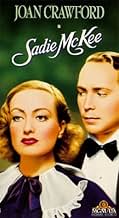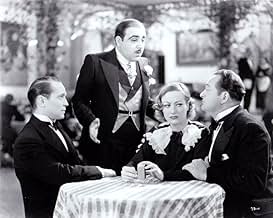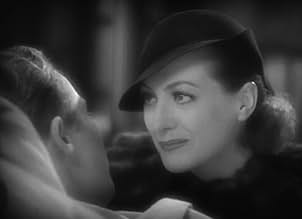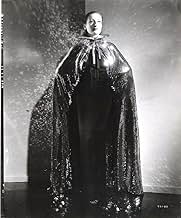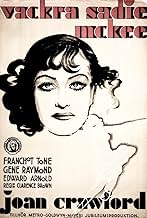CALIFICACIÓN DE IMDb
6.8/10
1.8 k
TU CALIFICACIÓN
La fortuna de una chica trabajadora mejora cuando se casa por dinero, pero la felicidad no se gana tan fácilmente.La fortuna de una chica trabajadora mejora cuando se casa por dinero, pero la felicidad no se gana tan fácilmente.La fortuna de una chica trabajadora mejora cuando se casa por dinero, pero la felicidad no se gana tan fácilmente.
- Dirección
- Guionistas
- Elenco
- Premios
- 3 premios ganados en total
Leo G. Carroll
- Phelps
- (as Leo Carroll)
Candy Candido
- Cafe Entertainer
- (as Candy and Coco)
Otto Heimel
- Cafe Entertainer
- (as Candy and Coco)
Norman Ainsley
- Second Butler - at Downstairs Meeting
- (sin créditos)
Hooper Atchley
- Intern with Dr. Briggs
- (sin créditos)
Nellie Bly Baker
- Downstairs Laundress
- (sin créditos)
Jack Baxley
- Short-Order Cook
- (sin créditos)
- Dirección
- Guionistas
- Todo el elenco y el equipo
- Producción, taquilla y más en IMDbPro
Opiniones destacadas
Clarence Brown was an above average director and his pictures with Joan Crawford in the early and mid '30s are better than those she did with others. Brown had an eye and a sense of detail and he favors long takes with two or more performers interacting, which creates a certain tension where there might otherwise be none. Certainly this improbable script is not noticeably better than others Joan did around that time, but everything about this picture works perfectly.
Having finally found her best 'look,' Crawford is undeniably gorgeous, the ravishing epitome of glamor. And Adrian does some of his best work for her in this, putting her in one stunning and flattering gown after another. She is also given a talented and varied supporting cast and all of the big set pieces work, though Edward Arnold's drunk scenes go on for too long.
And there are a couple of fantastic sets, one of Arnold's mansion and the other of a glass sanitarium in the snow. Though the whole cast is more than adequate, a few players stand out: Jean Dixon is delightfully world weary in a leopard coat, Esther Ralston makes a perfect amoral siren, and it's a bit of a revelation to see how much Leo G. Carroll accomplishes by doing very little in his role as a nasty butler. There's also a fantastic jazz version of "After You've Gone" performed by Gene Austin, Candy Candido and Otto Heimel. As for the main players, Crawford, Franchot Tone and Gene Raymond don't dig very deep in their performances, but with a plucky, luscious Crawford at full tilt and with everything else about this movie clicking so well, it doesn't matter. It works.
Having finally found her best 'look,' Crawford is undeniably gorgeous, the ravishing epitome of glamor. And Adrian does some of his best work for her in this, putting her in one stunning and flattering gown after another. She is also given a talented and varied supporting cast and all of the big set pieces work, though Edward Arnold's drunk scenes go on for too long.
And there are a couple of fantastic sets, one of Arnold's mansion and the other of a glass sanitarium in the snow. Though the whole cast is more than adequate, a few players stand out: Jean Dixon is delightfully world weary in a leopard coat, Esther Ralston makes a perfect amoral siren, and it's a bit of a revelation to see how much Leo G. Carroll accomplishes by doing very little in his role as a nasty butler. There's also a fantastic jazz version of "After You've Gone" performed by Gene Austin, Candy Candido and Otto Heimel. As for the main players, Crawford, Franchot Tone and Gene Raymond don't dig very deep in their performances, but with a plucky, luscious Crawford at full tilt and with everything else about this movie clicking so well, it doesn't matter. It works.
Joan Crawford is "Sadie McKee" in this 1934 film also starring Gene Raymond, Edward Arnold, Franchot Tone, and Jean Dixon. Crawford is the daughter of the cook for the wealthy Alderson family. The young man of the family, Michael (Tone) has obviously fallen for Sadie, but her heart belongs to loser Tommy Wallace (Raymond), who has just been fired for a malfeasance. Sadie runs off to New York with Tommy, and the two wind up in the rooming house of Mrs. Craney. The next day, they are to be married at City Hall at noon. But showgirl Dolly Merrick (Esther Ralston) who also lives at the rooming house, hears Tommy's dulcet tones and convinces him to forget marriage, leave town, and take a job in her traveling show.
Another women rooming at Mrs. Craney's is Opal, who gets Sadie a job at her club. There Sadie meets the filthy rich, drunken Jack Brennan, whom she marries. It turns out that Jack's drinking has all but destroyed his health. Though Sadie can't stop thinking about Tommy, she is determined to help Jack quit drinking and regain his health.
Pretty good melodrama, with Crawford wearing some fabulous outfits. Esther Ralston was a gorgeous blonde and is a lively Dolly Merrick, and Jean Dixon gives a good performance as Opal.
The debonair Franchot Tone gives a smooth performance as Michael, and Gene Raymond sings and acts pleasantly enough as Tommy, who manages to be likable though he walked out on Sadie.
Crawford made a lot of this type of film -- the working girl who moves up in class -- and they were very popular. She gives an appealing performance, and she was one actress who could look and act like a hard-working girl who came from a slum and also pull off being glamorous and wealthy.
Worth seeing.
Another women rooming at Mrs. Craney's is Opal, who gets Sadie a job at her club. There Sadie meets the filthy rich, drunken Jack Brennan, whom she marries. It turns out that Jack's drinking has all but destroyed his health. Though Sadie can't stop thinking about Tommy, she is determined to help Jack quit drinking and regain his health.
Pretty good melodrama, with Crawford wearing some fabulous outfits. Esther Ralston was a gorgeous blonde and is a lively Dolly Merrick, and Jean Dixon gives a good performance as Opal.
The debonair Franchot Tone gives a smooth performance as Michael, and Gene Raymond sings and acts pleasantly enough as Tommy, who manages to be likable though he walked out on Sadie.
Crawford made a lot of this type of film -- the working girl who moves up in class -- and they were very popular. She gives an appealing performance, and she was one actress who could look and act like a hard-working girl who came from a slum and also pull off being glamorous and wealthy.
Worth seeing.
In Richley, New York, Sadie McKee (Joan Crawford) works as a maid in the Alderson mansion where her mother is the cook. When the son of their employee, the successful lawyer Michael Alderson (Franchot Tone) that was raised with her, returns from New York after two years, his family offers a dinner party to family and friends. While serving soup, Sadie hears the comments made by Michael about her boyfriend Tommy Wallace (Gene Raymond), who was fired from the Alderson factory accused of being a dishonest person. Sadie reacts and tells that they are insensitive. Sadie decides to flee with Tommy to New York to get married and find job. They befriend Opal (Jean Dixon) and she takes them to the low- budget boardinghouse where she lives. On the next morning, Sadie leaves the boardinghouse to seek a job and marry her beloved Tommy. But his next room neighbor Dolly Merrick (Esther Ralston) overhears him singing and seduces Tommy to travel with her in an itinerant show business. Sadie prepares to return home, but Opal convinces her to stay and finds a job of dancer in a nightclub. Ten days later, Sadie is helped by an alcoholic costumer to get rid of an abusive one and he invites her to join him at his table. She learns that he is the millionaire Jack Brennan (Edward Arnold) and his friend is Michael Alderson. When Michael patronizes her telling to leave Jack, she is still angry with Michael and stays with Jack that proposes to marry her. She accepts and is seen by the society as a gold-digger. But Sadie is still in love with Tommy. What will happen to her?
"Sadie McKee" is a Pre-Code drama with the story of a working girl in love with a rascal that marries a wealthy girl. The role is perfect for Joan Crawford. The amoral story has a great open conclusion where the viewer needs to guess the birthday wish of Michael. My vote is six.
Title (Brazil): "Três Amores" ("Three Loves")
"Sadie McKee" is a Pre-Code drama with the story of a working girl in love with a rascal that marries a wealthy girl. The role is perfect for Joan Crawford. The amoral story has a great open conclusion where the viewer needs to guess the birthday wish of Michael. My vote is six.
Title (Brazil): "Três Amores" ("Three Loves")
"Sadie McKee" was made just before Hollywood got serious about sanitizing its content, and the movie is set squarely in what we now call the pre-Code world. In this world, men are on the make, cops are on the take, rich people do pretty much as they please and prostitution is just another job option.
But while many other pre-Code film can leave you with a bleak feeling about human nature, this one is stocked with basically decent characters. Bribe-takers are just ordinary folks trying to get by. A clever seducer can't silence his own conscience. And when an aging, drunken millionaire orders up a young girl and takes her home for the night, the relationship quickly blossoms from exploitation into an odd kind of love.
Joan Crawford plays the title role, a plucky survivor whose ups and downs would have broken a lesser person. Gene Raymond, Franchot Tone and Edward Arnold play the three very different men in her life. The story is improbable at times, moving from flophouse to sleazy nightclub to mansion. But it's never gets so unrealistic that you stop caring. The ending is somewhat enigmatic, at least to me. I'm still wondering exactly where everyone stood at the end, and where things were headed. That's OK. I like a movie that leaves a little something nagging at you.
If the story is improbable, there's nothing unbelievable about how Joan Crawford's character turns men's heads. A lot of people still view Crawford through a "campy" lens, remembering her long years as a fading star with a lot of personal baggage (real and reputed). Forget all that stuff. In 1934 she was young and lithe and simply gorgeous. She carries this movie, and she carries it well.
But while many other pre-Code film can leave you with a bleak feeling about human nature, this one is stocked with basically decent characters. Bribe-takers are just ordinary folks trying to get by. A clever seducer can't silence his own conscience. And when an aging, drunken millionaire orders up a young girl and takes her home for the night, the relationship quickly blossoms from exploitation into an odd kind of love.
Joan Crawford plays the title role, a plucky survivor whose ups and downs would have broken a lesser person. Gene Raymond, Franchot Tone and Edward Arnold play the three very different men in her life. The story is improbable at times, moving from flophouse to sleazy nightclub to mansion. But it's never gets so unrealistic that you stop caring. The ending is somewhat enigmatic, at least to me. I'm still wondering exactly where everyone stood at the end, and where things were headed. That's OK. I like a movie that leaves a little something nagging at you.
If the story is improbable, there's nothing unbelievable about how Joan Crawford's character turns men's heads. A lot of people still view Crawford through a "campy" lens, remembering her long years as a fading star with a lot of personal baggage (real and reputed). Forget all that stuff. In 1934 she was young and lithe and simply gorgeous. She carries this movie, and she carries it well.
Joan Crawford acts up a storm in this well done, interesting soap opera like story of working girl Sadie, daughter of a cook, who is madly in love with a loser named Tommy (played by Gene Raymond). Sadie and Tommy run off together to NYC where they soon take up residence in this shabby, one-room apartment. The next day, big plans for job hunting and a noon appointment at the city hall to get married, but unfortunately for Sadie, Tommy the Rat is thrown in the path of a bad blonde/singer named Dolly who hires him on the spot to sing in her act, they kiss and run off together leaving poor Sadie waiting at the so-called altar. But Sadie pulls herself up by her boot straps, gets a job as a dancer, and meets a multi-millionaire (Edward Arnold) with a big drinking problem, while still holding the torch for her beloved Tommy.
This film is quite a good one, the story completely held my interest, and the acting is top-notch with Joan Crawford giving out her full emotional range, Edward Arnold is excellent playing drunk for the majority of his scenes, and Esther Ralston does a good job as Dolly, the loose hipped, barely able to sing man-snatcher. Franchot Tone plays a lawyer, the son of the well-to-do home where Sadie was raised - he isn't given as much to do here as I would have liked but still gives a satisfying performance, and he certainly looks handsome enough, as usual. The film includes a few fun to watch musical numbers, plus some interesting scenes filmed in diners and a neat old-time Automat.
This film is quite a good one, the story completely held my interest, and the acting is top-notch with Joan Crawford giving out her full emotional range, Edward Arnold is excellent playing drunk for the majority of his scenes, and Esther Ralston does a good job as Dolly, the loose hipped, barely able to sing man-snatcher. Franchot Tone plays a lawyer, the son of the well-to-do home where Sadie was raised - he isn't given as much to do here as I would have liked but still gives a satisfying performance, and he certainly looks handsome enough, as usual. The film includes a few fun to watch musical numbers, plus some interesting scenes filmed in diners and a neat old-time Automat.
¿Sabías que…?
- TriviaOne of the first films to treat alcoholism as a serious problem, instead of a comic device.
- ErroresWhen Tommy is in his hospital room he makes Dr. Briggs promise not to tell Sadie of his condition. However, when Dr. Briggs leaves the room, Sadie is there with the other doctors and she already knows. Dr. Briggs then says, "He made me promise he wouldn't tell her." This dialogue obviously makes no sense and is wrong. What he meant to say was, "He made me promise not to tell her."
- Citas
Sadie McKee Brennan: [showing off her bedroom] Here it is.
Opal: Lady, when you say, "I do take thee," how you take him.
Sadie McKee Brennan: [chuckles]
Opal: Got this all to yourself?
Sadie McKee Brennan: Yep, all to myself.
Opal: Always all to yourself?
Sadie McKee Brennan: Yep.
Opal: Well, a whole lot of us do a whole lot more for a whole lot less.
- ConexionesFeatured in ¿Qué pasó con Baby Jane? (1962)
- Bandas sonorasAll I Do Is Dream Of You
(1934) (uncredited)
Music by Nacio Herb Brown
Lyrics by Arthur Freed
Played during the opening credits
Sung by Gene Raymond three times
Sung also by Earl Oxford in a show
Selecciones populares
Inicia sesión para calificar y agrega a la lista de videos para obtener recomendaciones personalizadas
- How long is Sadie McKee?Con tecnología de Alexa
Detalles
Taquilla
- Presupuesto
- USD 612,000 (estimado)
- Tiempo de ejecución1 hora 33 minutos
- Color
- Relación de aspecto
- 1.37 : 1
Contribuir a esta página
Sugiere una edición o agrega el contenido que falta

Principales brechas de datos
By what name was Sadie McKee (1934) officially released in India in English?
Responda
